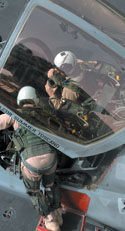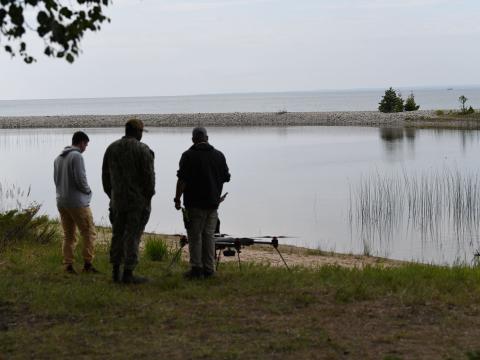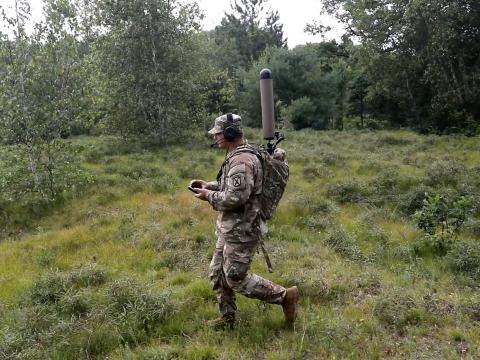Service Aims to Master Threats Before the Bad Guys
 |
| Three U.S. Air Force electronic warfare specialists create and route test signals, and field a call from the maintenance supervisor, from a maintenance station aboard an RC-135 Rivet Joint reconnaissance aircraft. The Air Force Research Laboratory is developing a Virtual Combat Environment for Electronic Conflict to ensure the military stays at the cutting edge of sensor technologies and electronic warfare. |
The U.S. Air Force intends to ensure that American troops are not caught unawares by electronic threats. The service is creating a virtual environment that will identify and assess disruptive and other major change technologies that could affect the future battlefield. The experiments will keep the
The Air Force Research Laboratory at Wright-Patterson Air Force Base, Ohio, has embarked on a 72-month effort to develop the Virtual Combat Environment for Electronic Conflict (VCEEC, pronounced v-seek) within the Sensors Directorate’s Virtual Combat Laboratory (VCL). “The virtual combat environment will prepare the U.S. Air Force and other services for a wide range of challenges, including traditional, irregular, catastrophic and disruptive threats,” explains Barbara Masquelier, VCEEC program manager.
The objective for VCEEC is to develop an environment that supports four main goals: the design, development and procurement of advanced electronic warfare, cyberspace and information operations technologies; the evaluation, demonstration and acquisition of new sensor technologies; the development and demonstration of layered sensing and battle management techniques; and the identification and evaluation of game-changing disruptive technologies.
To be effective, the virtual environment must represent the electromagnetic spectrum to support radio frequency countermeasure development, enable sensor utility analysis, represent Integrated Air Defense Systems attack and sensors, and permit software application development. In addition, the VCEEC needs to assist warfighter analysis, support development of electronic warfare battle management methods and technologies, and allow evaluation of layered sensing tools and concepts. Finally, it must enable the demonstration of network-centric technologies and produce future electronic warfare, cyberspace and information operations system designs and applications.
The larger VCL is a sensor research facility that supports developmental testing and evaluation of advanced sensor technologies, electronic warfare concepts, cyberspace and information operations concepts and research tools. The laboratory has high-fidelity sensor models, platform and virtual threat simulators, datalinks and navigation modes. Personnel use the systems-of-systems virtual battlespace within the VCL to baseline sensor performance for Air Force-wide implementation.
Using the combat laboratory for development, test and evaluation helps to lower sensor evaluation and testing costs. It also offers a realistic evaluation of Air Force concepts of operations and enables warfighters to perform military utility analyses on advanced sensor technologies. “The VCL is a unique facility for the development, test and evaluation of advanced electronic warfare concepts and tools,” Masquelier explains. “Our VCL does not provide a training environment, but supports the evaluation of advanced sensor performance and countermeasure technologies before fielding to our warfighters.” VCEEC is not the first effort to be performed in the facility.
Earlier in the year, the Air Force awarded two six-year contracts for VCEEC work to Booz Allen Hamilton and Northrop Grumman Mission Systems. “Booz Allen Hamilton has the VCEEC task order to develop a research environment for the evaluation of sensor technologies in a large systems-of-systems arena,” Masquelier says.
In addition to its basic contract, Northrop Grumman also was awarded a task order to create a plan for a disruptive technology innovation cell within the VCL. The objective of that task order is to identify current computer gaming and simulation tools that could be integrated with laboratory computer architecture to provide an environment that supports evaluation and application of potentially disruptive technology innovations. In the future the company may develop VCL infrastructure under the basic contract, but its first task is to investigate and document the requirements for developing the disruptive technology innovation cell.
“In order to maintain superiority, the
Northrop Grumman is developing a method to evaluate disruptive technologies. The methodology will include a structured study of potentially altering innovations and will address evaluating these innovations and assessing possible applications. The company’s approach will include ways to improve the military’s ability to scan existing and future technologies and to determine ways technologies will be used in combat scenarios. “We are specifically interested in developing a cell that will allow us to define future sensor webs, networked pointed sensors, ways our adversaries might negate radar stealth, ways that electromagnetic pulse radiation could shut down targeting systems, sensor spoofing and other game-changing advancements in sensing and electronic attack,” Masquelier explains.
The Air Force is not integrating contractor technologies into the VCL at this time. The VCEEC work involves maintaining and expanding the current modeling and simulation environment, which is based on open-system architectures and nonproprietary software applications. In-house scientists and engineers lead integration, validation and verification activities. “We also have peer reviews of our systems-of-systems environment on a regular basis,” Masquelier shares.
As the military transitions to more electronic attacks, information operations and other nonkinetic activities, the need to understand how the various factors interact in a dynamic, spectrum-filled environment becomes more critical. The Air Force is attempting to understand better how certain technologies or actions impact the battlespace. According to Mike Hushion, business development manager at Northrop Grumman, part of his company’s job is to determine what game-changing actions can be taken in the information operations realm to change the battlefield. The government also is interested in the ability to examine readily available products’ applicability to become weapons. For example, in the past, no one considered a garage door opener as a weapon, but now such common objects are used to detonate explosives.
 |
| Two pilots assigned to the “Zappers” of Tactical Electronic Warfare Squadron VAQ-130 man their EA-6B Prowler before flight operations aboard the Nimitz-class nuclear-powered aircraft carrier USS Harry S Truman. The U.S. Air Force is working with the U.S. Navy on various electronic warfare research efforts. Electronic warfare can be especially critical to pilots, whose instrumentation can be disrupted while in flight. |
According to Hushion’s colleague, Sergio Navarro, the VCEEC program manager at Northrop Grumman, what makes the virtual environment unique is that it examines nontraditional electronic threats along with the traditional threats. Preparing the military in advance for the new dangers is a start to countering them. Navarro says the work is exciting because personnel are working up initial concepts to deal with the novel threats warfighters face. His team develops the concepts and technologies for dealing with the modern dangers. And with the VCL, the military has the opportunity to test the technologies in a new way.
The military branches already test new technologies offered by private developers before releasing the capabilities onto the battlefield, writing the concept of operations before deployment. With the VCL, developers are able to create the first level of interaction that permits troops to examine how specific techniques and algorithms of electronic attack weapons can be used on the battlefield with a high level of simulation. Typically, the developers will look at individual capabilities first and then as the technology matures, they can see how various technologies work together. Navarro explains that over time, experts will define and model a strong subset of capabilities and that watching the different systems interoperate in a pre-real-world environment is a benefit for operators.
Developers are still at the beginning stages of understanding how to exploit electronic spectrum on the battlefield. New technologies are being created, and intelligence, surveillance and reconnaissance capabilities have grown significantly over the last several years.
Personnel are learning how to use the products and engage them against enemy forces. One of the challenges is trying to understand the broad spectrum of activities and determine how to influence events that occur in that spectrum. Navarro says these challenges are why VCEEC activity is underway. “It’s an attempt to really solidify those concepts out there today,” he says. Developers want to determine which ideas are most effective in the simulated environment with the different technologies and concepts. They can determine which approach will yield the best results in specific scenarios. “I think that’s where you’ll really see the benefit,” he shares.
Questions that VCEEC developers might consider include what happens when forces inject disruptive technology in old-fashioned jamming situations. Or, what happens if the jammers do something unexpected? Developers also must overcome the challenge of managing spectrum efficiently.
Currently, Northrop Grumman is performing concept studies on various techniques the military might use. After the concept phase concludes, the company believes various technologies will be incorporated and evaluated. The integration date, along with decisions on when troops could be actively involved in the technology, will be determined later. Reaching those next levels requires time, as well as determinations on funding and requirements definition.
While the work may be funded and provided for the Air Force Research Laboratory, all the military services will benefit from the research. Hushion explains that the Air Force has the lead on the effort, but in today’s battle environment, no war is fought by a single service. “Under joint doctrine, we all fight together,” he says. The four military branches conduct operations together, and all those participants on the electronic battlefield can be brought into the facility.
According to Masquelier, the Air Force is working now with the U.S. Navy on several different electronic warfare research efforts, and the services will use the VCL to evaluate the jointly developed technologies before they are actually implemented. “The research environment in the VCL allows us to evaluate robust sensors and adaptive countermeasures to guarantee complete freedom of air, space and cyber operations for our services, and to deny these capabilities to our adversaries,” she says.
Web Resources
Air Force Research Laboratory Sensors Directorate: www.wpafb.af.mil/afrl/ry/
Northrop Grumman
Booz Allen Hamilton: www.boozallen.com


Comments